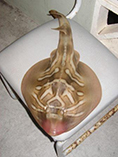| Family: |
Trygonorrhinidae (Banjo rays, Fiddler rays) |
| Max. size: |
120 cm TL (male/unsexed); max.weight: 6,700.0 g |
| Environment: |
demersal; marine; depth range 0 - 100 m |
| Distribution: |
Southwest Pacific: endemic to eastern Australia. |
| Diagnosis: |
This large shovelnose ray is distinguished by the following characters: suboval disc, short and broadly rounded snout with nostrils partly covered with a large nasal curtain; sharp thorns present on mid-line of disc and shoulders; behind interorbital space is an ornate pattern of dark-edged bands with distinct triangular or diamond-shaped marking (Ref. 114953). |
| Biology: |
A benthic species and an active scavenger which will enter fish traps and often becoming ensnared by the disc (Ref. 6871). Found also on sandy bottoms and seagrass areas, often near rocky reefs (Ref. 12951). Mainly feeds on crabs and shrimps (Ref. 114953). Ovoviviparous with golden egg capsules, each with up to 3 embryos (Ref. 12951). Produces up to 2-3 pups. Length size seldom exceeds 110 cm TL; birth size at ca. 25 cm TL (Ref. 114953). The flesh is good to eat, although only a small quantity is sold in seafood outlets (Ref. 6871). |
| IUCN Red List Status: |
Least Concern (LC); Date assessed: 27 March 2015 Ref. (130435)
|
| Threat to humans: |
harmless |
Source and more info: www.fishbase.org. For personal, classroom, and other internal use only. Not for publication.

